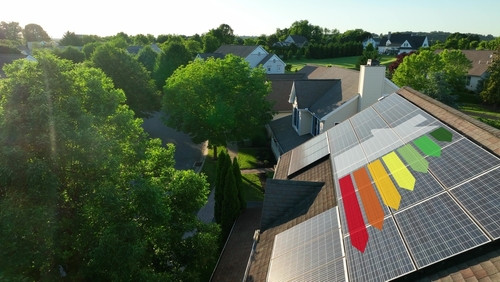Knowledge hub

Why Is The SAP Calculator Being Retired?
Since 2006, every newly built home in England and Wales has had it’s energy performance calculated using the Standard Assessment Procedure, better known as SAP.
And since 2008, SAP has been used to generate Energy Performance Certificates (EPCs) for millions of house sales and tenancy agreements across the United Kingdom.
If your house has an EPC rating, a SAP assessor was involved somewhere along the line.
We don’t use the same SAP methodology as we did in 2006… every few years it gets upgraded to be more accurate; which often involves the inclusion of more complicated modelling inputs for the assessor to deal with.
But SAP does have a fundamental issue – the foundations of the methodology are still routed in the original version, which limits how detailed and how flexible the SAP model can be.
Over the years, there have been growing calls for us to abandon SAP in favour of a more dynamic approach to measuring the energy performance of buildings – the likes of PassivHaus are often suggested as an alternative approach.
Now, the UK Government is working on a project to build a brand new modelling tool. The Home Energy Model ‘HEM’ will replace SAP when Part L of Building Regulations changes in England next year, and is expected to be quickly rolled out across all regions in the UK for both new builds and existing house sales.
So if it acts like a SAP calculation, and does the job of a SAP calculation, why not call it a SAP calculation?
The simple answer is that the Home Energy Model isn’t just a SAP calculator. The big-picture aim of HEM is to create a single tool that can be used for lots of different things. For example, testing running costs of a house based on real energy tariffs, testing heating systems to find the most efficient radiator size, looking at performance based on regional weather data, and maybe in the future, it can also be used to check overheating and suitable air flow rates. The list goes on...
The Government is keen to separate HEM from SAP, because SAP will just be a fraction of what HEM can potentially deliver.
Is this really necessary?
As we prepare to build homes that align with the Future Homes Standard and the UK’s net-zero ambitions, we’re going to be adopting heat pumps, photovoltaic panels and energy storage systems as standard.
The problem SAP has with all this clever tech is that usage rates and efficiencies vary hour by hour. To calculate the annual energy use of a dwelling, SAP runs 12 iterations – one per month. It knows how much power a PV panel should generate in a typical month, but it can’t consider the daily fluctuations in output, nor can it consider that against occupancy behaviour, so can’t accurately predict when a battery is charging, or being drained.
HEM will run 30 minute iterations to generate annual results. That’s 17,540 iterations. It sounds like a crazy level of detail, but this is what’s needed to allow the model to calculate the energy demand of a dwelling, considering generated and stored power.
That’s not HEM’s only trick. It will also adjust the heat pump efficiency every 30 minutes – this is also something SAP can only do monthly.
And assessors will also be able to consider load shifting technology, such as washing machines that switch themselves on when the electricity is cheapest or when the grid carbon emissions are at their lowest.
For manufacturers, a big benefit of HEM is that the calculations are open source and publicly available. Designers of new tech can build bespoke models to test their products before having the technology added to the HEM modules.
When will we be saying goodbye to SAP?
For new build developments, we’ll be keeping SAP calculations for any sites being built to the current or previous versions of the regs. Sites that fall under the next release of Building Regulations will move to HEM models.
In the existing dwelling market, we’re expecting the HEM roll-out to begin soon after, in preparation for changes to the EPC certificates which are expected to be enforced from 2028.
Frequently Asked Questions (FAQs)
Why is the SAP calculator being retired?
The SAP calculator is being retired because it is based on outdated methodology. The Home Energy Model (HEM) will replace SAP to provide more accurate and modern assessments, aligning with the UK's net-zero goals.
What is the Home Energy Model (HEM)?
The Home Energy Model (HEM) is a new tool designed to replace SAP. It will offer more detailed and dynamic calculations, considering daily fluctuations in energy use, solar generation, battery storage, and more.
How does HEM differ from the SAP calculator?
Unlike SAP, which runs 12 monthly iterations, HEM will run 30-minute iterations, providing 17,540 data points for a more precise calculation of energy use. This allows HEM to consider daily variations in energy generation, storage, and consumption, which SAP cannot.
When will SAP be fully replaced by HEM?
SAP will continue to be used for new builds that comply with the current or previous building regulations. However, when the next version of Building Regulations is released, new builds will switch to HEM. The HEM rollout for existing dwellings is expected to start soon after, ahead of new EPC requirements in 2028.
What is the timeline for the rollout of HEM?
HEM will be implemented with the next version of Building Regulations for new builds. The rollout for existing homes, including updates to EPCs, is expected to start soon after, likely by 2028.
Contact Us
Have questions or need assistance? Contact us today, and we'll be happy to help.
Address
AES Sustainability Limited
4b Oaklands Court
Tiverton Way
Tiverton Business Park
Tiverton
Devon EX16 6TG
Contact
01884 242050
info@aessc.co.ukDesigned by Optix Solutions. Developed by morphsites®
This website uses cookies to ensure you get the best experience. Learn more